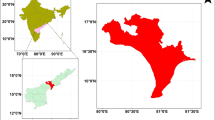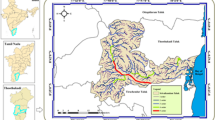Abstract
A novel method has been proposed in this study for delineation of flood-prone areas through integration of catastrophe theory and analytical hierarchy process (AHP) in a geographical information system. Seven causative flood factors were selected for this purpose based on data availability and literature reviews, namely, ground surface elevation, slope angle, curvature, topographic wetness index, stream power index, curve numbers, and distance from intermittent streams. The raster maps of the factors were prepared with a cell size of 30 × 30 m. The catastrophe models were used to derive weights of the factors using weighted linear combination technique, while AHP was used to compute normalized ranks of the classes of each factor. The model was applied to demarcate the flood-prone zones in northeastern parts of Southern Iraq, where flash flood is a recurrent natural hazard that causes damage to property almost every year. The study revealed that about 852 km2 (41 %) of the study area is less susceptible, 434 km2 (21 %) is moderate susceptible and 812 km2 (38 %) is high susceptible to flood. The high flood-susceptible zones are mainly distributed around the intermittent streams and the low lands in the southeast, while the low flood-susceptible zones are found in the east and northeast hilly regions of the study area. The obtained result matches well with general conception of flood-prone zones in the region, which indicates that integration of catastrophe theory and AHP can provide a low cost and easily implementable method for reliable mapping of flush flood-susceptible zones.











Similar content being viewed by others
References
Ahmed K, Shahid S, Bin Harun S, Ismail T, Nawaz N, Shamsudin S (2014) Assessment of groundwater potential zones in an arid region based on catastrophe theory. Earth Sci Inform. doi:10.1007/s12145-014-0173-3
Ajin RS, Krishnamurthy RR, Jayaprakash M, Vinod PG (2013) Flood hazard assessment of Vamanapuram River Basin, Kerala, India: an approach using remote sensing and GIS techniques. Adv Appl Sci Res 4(3):263–274
Al-Abadi AM, Shahid S (2015) A comparison between index of entropy and catastrophe theory methods for mapping groundwater potential in an arid region. Environ Monit Assess 187(9):576. doi:10.1007/s10661-015-4801-2
Al-Abadi AM, Al-Shamma’a AM, Aljabbari MH (2014) A GIS-based DRASTIC model for assessing intrinsic groundwater vulnerability in northeastern Missan governorate, southern Iraq. Appl Water Sci. doi:10.1007/s13201-014-0221-7
Asare-Kyei DK, Kloos J, Renaud FG (2015) Multi-scale participatory indicator development approaches for climate change risk assessment in West Africa. Int J Disaster Risk Reduct 11:13–34
Ayalew L, Yamagishi H (2005) The application of GIS-based logistic regression for landslide susceptibility mapping in the Kakuda-Yahiko Mountains, Central Japan. Geomorphology 65(1–2):15–31
Borga M, Anagnostou EN, Blöshl G, Creutin JD (2011) Flash flood forecasting, warning and risk management: the HYDRATE project. Environ Sci Policy 14:834–844
Budhakooncharoen S, Dhabhisara B (2014) Determination of the weighting factors of criteria influencing highway flooding using multi criteria analysis based on an analytic hierarchy process. WIT Trans Inf Commun Technol 47:451–463
Cantos JO (2005) Country report—Spain. In: Greiving S, Fleischhauer M, Wanczura S (eds) Report on the European scenario of technological and scientific standards reached in spatial planning versus natural risk management. ARMONIA Project, Dortmund
Carr M, Zwick P (2007) Smart land-use analysis: the LUCIS model. ESRI press, Redlands
Chen YF, Yin CF, Lu GF (2006) The catastrophic model of water bloom: a case study on Lake Chaohu. Acta Ecol Sin 26:878–883
Chowdary VM, Chakraborthy D, Jeyaram A, Krishna Murthy YVN, Sharma JR, Dadhwal VK (2013) Multi-criteria decision making approach for watershed prioritization using analytic hierarchy process technique and GIS. Water Resour Manage 27(10):3555–3571. doi:10.1007/s11269-013-0364-6
de Moel H, van Alphen J, Aerts JCJH (2009) Flood maps in Europe—methods, availability and use. Nat Hazards Earth Syst Sci 9:289–301
de Winnaar G, Jewitt GPW, Horan M (2007) A GIS-based approach for identifying potential runoff harvesting sites in the Thukela River basin, South Africa. Phys Chem Earth 32(15):1058–1067. doi:10.1016/j.pce.2007.07.009
Ghasemi A, Salajegheh A, Malekian A, Esmaliouri A (2014) Investigation of flooding and causative factors in Balegli Chay watershed by GIS, RS, and AHP techniques. J Environ Stud 40(2):389–400
Ghorbani MA, Khatibi R, Sivakumar B, Cobb L (2010) Study of discontinuities in hydrological data using catastrophe theory. Hydrol Sci J 55:1137–1151. doi:10.1080/02626667.2010.513477
Hirabayashi Y, Mahendran R, Koirala S, Konoshima L, Yamazaki D, Watanabe S, Kim H, Kanae S (2013) Global flood risk under climate change. Nat Clim Change 3:816–821. doi:10.1038/nclimate1911
Hui Q (2008) Niche, factor interaction and business evolution—the enterprise niche research of the growth business. Zhejiang University Press, Hangzhou
Jonkman SN, Hiel LA, Bea RG, Foster H, Tsioulou A, Arroyo P, Stallard T, Harris L (2012) Integrated risk assessment for the Natomas Basin (CA) analysis of loss of life and emergency management for floods. ASCE Nat Hazards Rev 13:297–309
Kam JK (1992) Are chaos and catastrophe theories relevant to environmental sciences? J Environ Sci 4:39–42
Kandilioti G, Makropoulos C (2012) Preliminary flood risk assessment: the case of Athens. Nat Hazards 61(2):441–468. doi:10.1007/s11069-011-9930-5
Kia MB, Pirasteh S, Pradhan B, Mahmud AR, Sulaiman WNA, Moradi A (2012) An artificial neural network model for flood simulation using GIS: Johor river basin, Malaysia. Environ Earth Sci 67(1):251–264. doi:10.1007/s12665-011-1504-z
Lee S, Kim YS, Oh HJ (2012) Application of a weights-of-evidence method and GIS to regional groundwater productivity potential mapping. J Environ Manage 96(1):91–105
Li P-Y, Hui Q, Jian-Hua WU (2010) Groundwater quality assessment based on improved quality index in Pengyang County, Ningxia, northeast China. J Chem 7:209–216
Lillesand TM, Kiefer RW (2000) Remote sensing and image interpretation. Wiley, New York
Lodwik WA, Monson W, Svoboda L (1990) Attribute error and sensitivity analysis of maps operation in geographical information systems—suitability analysis. Int J Geogr Inf Syst 4:413–428
Majandang J, Sarapirome S (2012) Groundwater vulnerability assessment and sensitivity analysis in Nong Rua, Khon Kaen, Thailand, using a GIS-based SINTACS model. Environ Earth Sci 68:2025–2039. doi:10.1007/s12665-012-1890-x
McDonald RC, Isbell RF, Speight JG, Walker J, Hopkins MS (1990) Australian land and soil survey field handbook, 2nd edn. Inkata Press, Melbourne
Moore ID, Grayson RB, Ladson AR (1991) Digital terrain modeling: a review of hydrological, geomorphological and biological applications. Hydrol Process 5:3–30
Mustafa MA, Al-Bahar JF (1991) Project risk assessment using the analytic hierarchy process. IEEE Trans Eng Manage 38(1):46–52
Napolitano P, Fabbri AG (1996) Single parameter sensitivity analysis for aquifer vulnerability assessment using DRASTIC and SINTACS. In: Proceedings of the Vienna 576 page 20 of 21 Environ Monit Assess (2015) 187:576. Conference on HydroGIS 96: application of geographic information system in hydrology and water resources management. IAHS Publications, vol 235, pp 559–566
Nasiri H, Boloorani AD, Sabokbar HAF, Jafari HR, Hamzeh M, Rafii Y (2013) Determining the most suitable areas for artificial groundwater recharge via an integrated PROMETHEE II-AHP method in GIS environment (case study: Garabaygan Basin, Iran). Environ Monit Assess 185(1):707–718. doi:10.1007/s10661-012-2586-0
Ouma YO, Tateishi R (2014) Urban flood vulnerability and risk mapping using integrated multi-parametric AHP and GIS: methodological overview and case study assessment. Water 6(6):1515–1545
Papaioannou G, Vasiliades L, Loukas A (2014) Multi-criteria analysis framework for potential flood prone areas mapping. Water Resour Manage 29(2):399–418. doi:10.1007/s11269-014-0817-6
Pradhan B, Youssef AM (2011) A 100-year maximum flood susceptibility mapping using integrated hydrological and hydrodynamic models: Kelantan river corridor, Malaysia. J Flood Risk Manage 4(3):189–202. doi:10.1111/j.1753-318X.2011.01103.x
Rahmati O, Pourghasemi HR, Zeinivand H (2015) Flood susceptibility mapping using frequency ratio and weights-of-evidence models in the Golastan Province, Iran. Geocarto Int 31(1):42–70. doi:10.1080/10106049.2015.1041559
Rajabi M, Mansourian A, Pilesjö P, Bazmani A (2014) Environmental modelling of visceral leishmaniasis by susceptibility-mapping using neural networks: a case study in north-western Iran. Geosp Health 9(1):179–191
Saaty TL (1980) The analytic hierarchy process. McGraw-Hill, New York
Saaty TL, Vargas LG (2000) Models, methods, concepts and applications of the analytic hierarchy process. Kluwer Academic Publishers, Boston
Tehrany MS, Pradhan B, Jebur MN (2013) Spatial prediction of flood susceptible areas using rule based decision tree (DT) and a novel ensemble bivariate and multivariate statistical models in GIS. J Hydrol 504:69–79
Tehrany MS, Pradhan B, Jebur MN (2014) Flood susceptibility mapping using a novel ensemble weights-of-evidence and support vector machine models in GIS. J Hydrol 512:332–343
Wang W, Liu S, Zhang S, Chen J (2011) Assessment of a model of pollution disaster in near-shore coastal waters based on catastrophe theory. Ecol Modell 222(2):307–312. doi:10.1016/j.ecolmodel.2010.09.007
Yang F, Shao D, Xiao C, Tan X (2012) Assessment of urban water security based on catastrophe theory. Water Sci Technol 66:487–493. doi:10.2166/wst.2012.182
Zhang TJ, Ren SX, Li SG, Zhang TC, Xu HJ (2009) Application of the catastrophe progression method in predicting coal and gas outburst. Min Sci Technol 19(4):430–434. doi:10.1016/S1674-5264(09)60080-6
Zimmerman M, Pozzi A, Stoessel F (2005) Hazard maps and related instruments, the Swiss system and its application abroad. Swiss Agency for Development and Cooperation (SDC), Swiss National Platform Natural Hazards (PLANAT), Bern, Switzerland
Author information
Authors and Affiliations
Corresponding author
Ethics declarations
Conflict of interest
The authors declare no conflict of interest.
Rights and permissions
About this article
Cite this article
Al-Abadi, A.M., Shahid, S. & Al-Ali, A.K. A GIS-based integration of catastrophe theory and analytical hierarchy process for mapping flood susceptibility: a case study of Teeb area, Southern Iraq. Environ Earth Sci 75, 687 (2016). https://doi.org/10.1007/s12665-016-5523-7
Received:
Accepted:
Published:
DOI: https://doi.org/10.1007/s12665-016-5523-7




